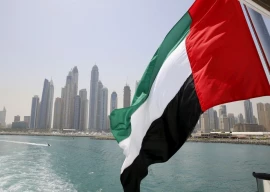
Pakistan is one of the many countries around the globe that have unequivocally demonstrated that ethnicity is a major hurdle on the way to creating a nation out of diversity. Muhammad Ali Jinnah, Pakistan’s founding father, paid more attention to culture than religion in demanding the division of the British Indian colony into two states — a Hindu dominated India and a Muslim dominated Pakistan. However, in his first address to the Pakistan Constituent Assembly delivered on August 11, 1947, three days before Pakistan won its independence, Jinnah made it clear that religion was not to be the basis of citizenship. The experiment he launched in 1947 lasted for just over a quarter century. The Bengalis, having struggled to gain some voice in governance, left Jinnah’s country and created their own state, Bangladesh. The name they gave their country put ethnicity up front in the building of the new nation.
India has also struggled to find a solution to the ethnic diversity within its large population. Until the time, Narendra Modi, the Hindu nationalist, gained power, India had made a success of what the Indian historian, Sunil Khilnani, described as the “idea of India” in the book of that title. He argued that by constructing a political order that gave adequate space to all religious and ethnic groups, India had found a way of keeping its diverse population within the confines of the state. Modi, by opting for Hindutva as the philosophy of governance, has dispensed with that idea. His political organisation, the Bhartiya Janata Party, by winning the recent election in the populous state of Uttar Pradesh, will continue to give preference to the followers of Hinduism over those who subscribe to different faiths. The question this raises is whether India can survive as one nation by pursuing Hindutva.
Afghanistan, another neighbour of Pakistan, is also struggling with the issue of nationhood as the Taliban continue their effort to consolidate their rule over the country over which they have established their control. Their own base is in the Pashtun ethnic group which is the largest in the country but does not have a majority. The problem of ethnicity becomes even greater when it overlaps religious differences. The Hazaras in Afghanistan are the third largest ethnic group after the Pashtuns and the Tajiks. However, since they follow the Shiite faith, they are targeted by the Taliban that subscribe to the extremist form of the Sunni sect. The quarrel between the followers of the Sunni and Shiites sects has spilled into Pakistan. The March 4 attack at a mosque in Peshawar by a Sunni extremist that claimed more than sixty lives is one indication of the impact on Pakistan of the Talibanisation of Afghanistan.
The Taliban have been in power for six months but have not been able to settle down in Kabul and begin to govern the war-torn country. The new government’s main challenge is to save its nearly 40 million people from an unparalleled humanitarian crisis. Millions of the country’s citizens are near-starvation and hospitals and clinics don’t have the wherewithal to take care of those who manage to reach them. This crisis is the result of the United States and its western allies withholding billions of dollars of Afghan money that has been deposited with foreign banks. This being done to punish them and then, it is hoped, to have the Taliban work for the country’s entire population not just for those who follow their radical Islamic faith or belong to the Pashtun ethnic group.
Sharp ethnic divisions in Afghanistan are one reason why the country has not been able to develop a strong central authority that could govern the entire country. The Pashto speaking Pashtuns are the largest ethnic group making up 42 per cent of the population. The Tajiks are the second largest ethnic group with 27 per cent of the population who live in the northeastern provinces. They have a strong presence in Panjshir Valley from where they offered stiff resistance to the Taliban forces in August and September 2021 as the Pashtun group attempted to establish their control over the entire country. Once defeated, some of the prominent Tajiks slipped across the border and took refuge in Tajikistan. There are more Tajiks — 11 million — in Afghanistan than in the country that carries their name. Ashraf Ghani, twice elected to the Afghan presidency, the first time in 2014 and the second time in 2019, appointed Amrullah Saleh, a Tajik, as the Vice President. When Ghani flew out of the county on August 15, 2021, Saleh declared himself to be the acting President, but the Taliban quickly moved into the presidential palace and the Tajik leader also left Kabul and went to Panjshir Valley and from there to Tajikistan.
Hazaras in the country’s central part and Uzbek in the northwest are the next two large ethnic groups, each with 9 per cent of the population. The Uzbeks also have a country that carries their name. With 35 million people, Uzbekistan is only a bit smaller than Afghanistan. However, the Uzbeks in Afghanistan were led by Abdul Rashid Dostum, a powerful warlord, who did not always follow the wishes of the central authority operating out of Kabul. He was a major army commander in the communist government which was in power before the Soviet Union sent in its troops to prevent the fall of that regime. He did not side with the mujahedeen groups that fought the Soviet troops and ultimately drove them out after they had stayed for ten years, from 1979 to 1989. Once the Soviets were out, the Taliban regime that assumed power in Kabul lasted for five years, from 1996 to 2001. Dostum sided with the government that was installed by the United States and its Western allies.
It doesn’t appear that the Taliban who are struggling to establish a functioning government in Kabul will be able to win the support of the various ethnic groups unless they opt for an inclusive state.
As one observer of the developing Afghan scene noted, “Here in Faryab province where Uzbeks are a majority, the ethnic fissures have been deepening for months. Even though many midlevel security and political officials are Uzbek, most residents viewed the Taliban appointment of an ethnic Turkmen governor and a Pashtun as his deputy as an attempt to dilute their community’s influence. The most powerful Uzbek was Alam, and then he was gone.” Talban were actively seeking to add more ethnic minorities to its ranks to project themselves as a national political force. Alam played a key role in recruiting more Uzbeks from Faryab and neighbouring provinces as well as Turkmen and Tajiks, although their number are small and are dwarfed by the Pashtuns. He was, however, taken prisoner and has disappeared.
Published in The Express Tribune, March 21th, 2022.
Like Opinion & Editorial on Facebook, follow @ETOpEd on Twitter to receive all updates on all our daily pieces.


















COMMENTS
Comments are moderated and generally will be posted if they are on-topic and not abusive.
For more information, please see our Comments FAQ